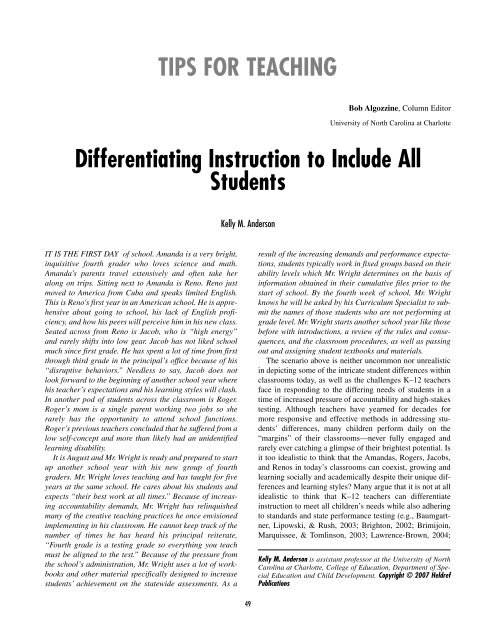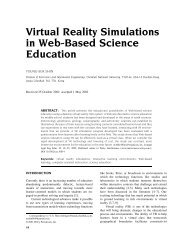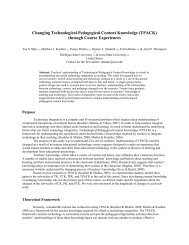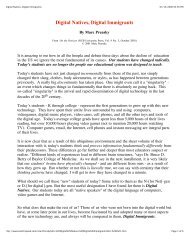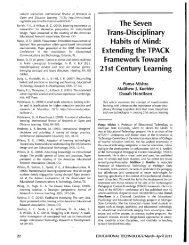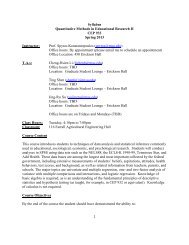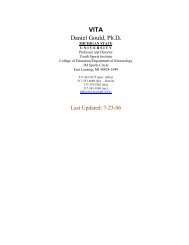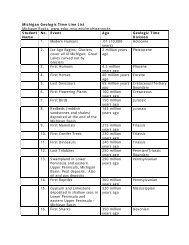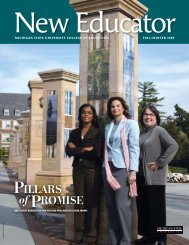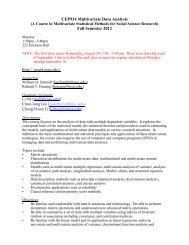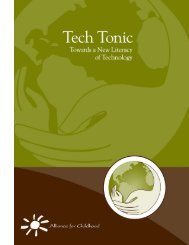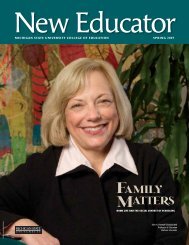Differentiating instruction to include all students. - Michigan State ...
Differentiating instruction to include all students. - Michigan State ...
Differentiating instruction to include all students. - Michigan State ...
Create successful ePaper yourself
Turn your PDF publications into a flip-book with our unique Google optimized e-Paper software.
TIPS FOR TEACHING<br />
Bob Algozzine, Column Edi<strong>to</strong>r<br />
University of North Carolina at Charlotte<br />
<strong>Differentiating</strong> Instruction <strong>to</strong> Include All<br />
Students<br />
Kelly M. Anderson<br />
IT IS THE FIRST DAY of school. Amanda is a very bright,<br />
inquisitive fourth grader who loves science and math.<br />
Amanda's parents travel extensively and often take her<br />
along on trips. Sitting next <strong>to</strong> Amanda is Reno. Reno just<br />
moved <strong>to</strong> America from Cuba and speaks limited English.<br />
This is Reno's first year in an American school. He is apprehensive<br />
about going <strong>to</strong> school, his lack of English proficiency,<br />
and how his peers will perceive him in his new class.<br />
Seated across from Reno is Jacob, who is “high energy”<br />
and rarely shifts in<strong>to</strong> low gear. Jacob has not liked school<br />
much since first grade. He has spent a lot of time from first<br />
through third grade in the principal’s office because of his<br />
“disruptive behaviors.” Needless <strong>to</strong> say, Jacob does not<br />
look forward <strong>to</strong> the beginning of another school year where<br />
his teacher’s expectations and his learning styles will clash.<br />
In another pod of <strong>students</strong> across the classroom is Roger.<br />
Roger’s mom is a single parent working two jobs so she<br />
rarely has the opportunity <strong>to</strong> attend school functions.<br />
Roger’s previous teachers concluded that he suffered from a<br />
low self-concept and more than likely had an unidentified<br />
learning disability.<br />
It is August and Mr. Wright is ready and prepared <strong>to</strong> start<br />
up another school year with his new group of fourth<br />
graders. Mr. Wright loves teaching and has taught for five<br />
years at the same school. He cares about his <strong>students</strong> and<br />
expects “their best work at <strong>all</strong> times.” Because of increasing<br />
accountability demands, Mr. Wright has relinquished<br />
many of the creative teaching practices he once envisioned<br />
implementing in his classroom. He cannot keep track of the<br />
number of times he has heard his principal reiterate,<br />
“Fourth grade is a testing grade so everything you teach<br />
must be aligned <strong>to</strong> the test.” Because of the pressure from<br />
the school’s administration, Mr. Wright uses a lot of workbooks<br />
and other material specific<strong>all</strong>y designed <strong>to</strong> increase<br />
<strong>students</strong>’ achievement on the statewide assessments. As a<br />
result of the increasing demands and performance expectations,<br />
<strong>students</strong> typic<strong>all</strong>y work in fixed groups based on their<br />
ability levels which Mr. Wright determines on the basis of<br />
information obtained in their cumulative files prior <strong>to</strong> the<br />
start of school. By the fourth week of school, Mr. Wright<br />
knows he will be asked by his Curriculum Specialist <strong>to</strong> submit<br />
the names of those <strong>students</strong> who are not performing at<br />
grade level. Mr. Wright starts another school year like those<br />
before with introductions, a review of the rules and consequences,<br />
and the classroom procedures, as well as passing<br />
out and assigning student textbooks and materials.<br />
The scenario above is neither uncommon nor unrealistic<br />
in depicting some of the intricate student differences within<br />
classrooms <strong>to</strong>day, as well as the ch<strong>all</strong>enges K–12 teachers<br />
face in responding <strong>to</strong> the differing needs of <strong>students</strong> in a<br />
time of increased pressure of accountability and high-stakes<br />
testing. Although teachers have yearned for decades for<br />
more responsive and effective methods in addressing <strong>students</strong>’<br />
differences, many children perform daily on the<br />
“margins” of their classrooms—never fully engaged and<br />
rarely ever catching a glimpse of their brightest potential. Is<br />
it <strong>to</strong>o idealistic <strong>to</strong> think that the Amandas, Rogers, Jacobs,<br />
and Renos in <strong>to</strong>day’s classrooms can coexist, growing and<br />
learning soci<strong>all</strong>y and academic<strong>all</strong>y despite their unique differences<br />
and learning styles? Many argue that it is not at <strong>all</strong><br />
idealistic <strong>to</strong> think that K–12 teachers can differentiate<br />
<strong>instruction</strong> <strong>to</strong> meet <strong>all</strong> children’s needs while also adhering<br />
<strong>to</strong> standards and state performance testing (e.g., Baumgartner,<br />
Lipowski, & Rush, 2003; Brigh<strong>to</strong>n, 2002; Brimijoin,<br />
Marquissee, & Tomlinson, 2003; Lawrence-Brown, 2004;<br />
Kelly M. Anderson is assistant professor at the University of North<br />
Carolina at Charlotte, College of Education, Department of Special<br />
Education and Child Development. Copyright © 2007 Heldref<br />
Publications<br />
49
50 Preventing School Failure Vol. 51, No. 3<br />
Smutny, 2003; Sternberg, Torff, & Grigorenko, 1998; Tomlinson,<br />
1999; Tomlinson, 2000).<br />
What Is Differentiated Instruction?<br />
Differentiation is not at <strong>all</strong> a new concept. The one-room<br />
schoolhouse is a prime example of teachers differentiating<br />
<strong>to</strong> meet the needs of <strong>all</strong> <strong>students</strong>. Differentiated <strong>instruction</strong><br />
stems from beliefs about differences among learners, how<br />
<strong>students</strong> learn, differences in learning preferences, and individual<br />
interests. By its nature, differentiation implies that<br />
the purpose of schools should be <strong>to</strong> maximize the capabilities<br />
of <strong>all</strong> <strong>students</strong>. Differentiated <strong>instruction</strong> integrates<br />
what we know about constructivist learning theory, learning<br />
styles, and brain development with empirical research on<br />
influencing fac<strong>to</strong>rs of learner readiness, interest, and intelligence<br />
preferences <strong>to</strong>ward <strong>students</strong>’ motivation, engagement,<br />
and academic growth within schools (Tomlinson &<br />
Allan, 2000). Unlike Mr. Wright, teachers who differentiate<br />
know they are incorporating best practices in moving <strong>all</strong> of<br />
their <strong>students</strong> <strong>to</strong>ward proficiency in the knowledge and<br />
skills established in state and local standards.<br />
Teachers who differentiate believe that every child is<br />
unique, with differing learning styles and preferences. They<br />
may differentiate based on <strong>students</strong>’ readiness by varying<br />
the levels of difficulty of the material covered in class.<br />
Teachers may opt <strong>to</strong> differentiate key skills and material <strong>to</strong><br />
be unders<strong>to</strong>od by aligning them with particular <strong>students</strong>’<br />
affinities and <strong>to</strong>pics of interest (i.e., geography, music,<br />
foods, wildlife, and architecture). Differentiation may be<br />
made by the teachers based on what they know about <strong>students</strong>’<br />
learning preferences (i.e., intelligences, talents,<br />
learning styles), <strong>all</strong>owing <strong>students</strong>’ choices in working independently,<br />
with partners, or as a team; or providing varied<br />
work spaces that are conducive <strong>to</strong> various learning preferences<br />
(i.e., quiet work spaces, work spaces with tables<br />
instead of desks). Of the utmost importance <strong>to</strong> the teacher<br />
who differentiates is providing a learning environment and<br />
opportunities that exclude no child.<br />
Critical Elements of Differentiated Instruction<br />
Most important <strong>to</strong> differentiated <strong>instruction</strong> are the elements<br />
of choice, flexibility, on-going assessment, and creativity<br />
resulting in differentiating the content being taught,<br />
or how <strong>students</strong> are processing and developing understanding<br />
of concepts and skills, or the ways in which <strong>students</strong><br />
demonstrate what they have learned and their level of<br />
knowledge through varied products. Teachers determine at<br />
the onset of their planning what their <strong>students</strong> should know<br />
and what each child should be able <strong>to</strong> do at the conclusion<br />
of the lesson or unit (Tomlinson, 2000).<br />
When differentiating the content aspect of a lesson,<br />
teachers may adapt what they plan for the <strong>students</strong> <strong>to</strong> learn<br />
or how the <strong>students</strong>’ will gain access <strong>to</strong> the desired knowledge,<br />
understanding, and skills (Tomlinson & Allan, 2000).<br />
Instead of varying the learner objectives and lowering performance<br />
expectations for some <strong>students</strong>, teachers may differentiate<br />
the content by using texts, novels, or short s<strong>to</strong>ries<br />
at varying reading levels. The teachers may choose <strong>to</strong> differentiate<br />
the content by using flexible grouping, affording<br />
<strong>students</strong> <strong>to</strong> work in alike groups using books on tape or the<br />
Internet as a means for developing understanding and<br />
knowledge of the <strong>to</strong>pic or concept. Some <strong>students</strong> may<br />
choose <strong>to</strong> work in pairs, sm<strong>all</strong> groups, or independently, but<br />
<strong>all</strong> are working <strong>to</strong>ward proficiency on the same performance<br />
standards or curriculum objectives.<br />
<strong>Differentiating</strong> the process within a lesson refers <strong>to</strong> how<br />
the learners come <strong>to</strong> understand and assimilate facts, concepts,<br />
or skills. In traditional lesson planning, the process<br />
is the guided and independent practice within a lesson.<br />
Despite differences in abilities, learning styles, and <strong>students</strong>’<br />
prior knowledge, this component of a lesson is typic<strong>all</strong>y<br />
a stable constant in most <strong>instruction</strong>al lessons,<br />
meaning that <strong>all</strong> <strong>students</strong> complete the same type and<br />
amount of practice.<br />
In the opening vignette of Mr. Wright’s class, Amanda,<br />
Reno, Jacob, and Roger might <strong>all</strong> practice identifying parts<br />
of a s<strong>to</strong>ry using the same workbook page with completion<br />
expected at the end of the day’s literacy block. Instead, the<br />
teacher may have chosen <strong>to</strong> differentiate based on <strong>students</strong>’<br />
readiness resulting in clustering the children in “alike” literacy<br />
circles; giving each group leveled questions based on<br />
their readiness skills related <strong>to</strong> the objective of the lesson.<br />
For example, because of his limited English proficiency,<br />
Reno may work with a group of peers who have less developed<br />
skills and need more direct <strong>instruction</strong> by a teacher,<br />
assistant, or parent volunteer. The questions for his group<br />
may be more concrete and less multi-leveled (e.g., Who are<br />
the characters within the s<strong>to</strong>ry? Where does the s<strong>to</strong>ry begin?<br />
What is the plot of the s<strong>to</strong>ry?). In contrast, Amanda may<br />
work in a group that is also expected <strong>to</strong> know and understand<br />
the parts of the s<strong>to</strong>ry, but because her reading and<br />
vocabulary skills are more developed, Amanda's group<br />
responds <strong>to</strong> more abstract and multi-leveled questions (e.g.,<br />
Who is the main character in the s<strong>to</strong>ry? Can you name at<br />
least two other fictional characters from other novels that<br />
have similar characteristics? Who are the supporting characters<br />
and why are they important <strong>to</strong> the s<strong>to</strong>ry? What is the<br />
main problem of the s<strong>to</strong>ry? Describe a time when you, or<br />
someone you know, had a similar problem.). Other ways <strong>to</strong><br />
differentiate the process aspect of a lesson <strong>include</strong> tiering<br />
the independent work activities, learning centers, and individualized<br />
homework enrichment projects (e.g., Baumgartner,<br />
Lipowski, & Rush, 2003; Brimijoin, Marquissee, Tomlinson,<br />
2003; George, 2005; Lawrence-Brown, 2004;<br />
Madea, 1994; Tomlinson & Allan, 2000; Wehrmann, 2000;<br />
Winebrenner, 1996).
Spring 2007 Anderson 51<br />
<strong>Differentiating</strong> the performance measure or product component<br />
of a lesson means affording <strong>students</strong> various ways of<br />
demonstrating what they have learned from the lesson or<br />
unit of study. Differentiation of assessments or products<br />
may be constructed in various ways by the teacher such as<br />
using choice boards (with predetermined options), or the<br />
use of open-ended lists of potential product options from<br />
which <strong>students</strong>’ select or contract for their final product.<br />
The purpose of the product (regardless of its format) is for<br />
<strong>students</strong> <strong>to</strong> rec<strong>all</strong> what they have learned in the lesson or<br />
unit. Differentiated products ch<strong>all</strong>enge <strong>students</strong> at <strong>all</strong> levels<br />
<strong>to</strong> make decisions, be responsible for their own learning, as<br />
well as affording them opportunities <strong>to</strong> demonstrate what<br />
they know through products that are representative of their<br />
unique learning preferences, interests, and strengths.<br />
In Mr. Wright’s classroom, products differentiated on the<br />
basis of <strong>students</strong>’ interests may mean that Amanda and<br />
Roger work <strong>to</strong>gether on demonstrating what they have<br />
learned about their state’s geography, whereas Jacob, Reno,<br />
and others may work as a sm<strong>all</strong> team <strong>to</strong> present on the main<br />
industry of the region. All <strong>students</strong> can work <strong>to</strong>ward demonstrating<br />
what they have learned through varying representations<br />
on the basis of their unique interests. Each individual<br />
is assessed using established criteria (typic<strong>all</strong>y, a rubric) by<br />
the teacher assessing <strong>students</strong>’ mastery of the knowledge<br />
and skills outlined within the lesson or unit. This approach<br />
<strong>to</strong> assessing <strong>students</strong>’ knowledge not only yields reliable<br />
assessment of their knowledge and skills but also provides<br />
evidence of each individual’s value <strong>to</strong> the learning process<br />
within the classroom.<br />
Getting Started<br />
For Mr. Wright, starting differentiation may begin with<br />
the creation of learning profiles; simple profiles of each student<br />
containing pertinent information specific <strong>to</strong> learning<br />
preferences, family structure, favorite hobbies and interests,<br />
and other aspects of interest. Each profile may also contain<br />
specific grade-level information for each child such as state<br />
assessment scores, Lexile reading scores, and fluency<br />
recordings. These individual student profiles are central <strong>to</strong> a<br />
teacher’s inspiration in planning engaging, student-centered<br />
differentiated lessons and <strong>instruction</strong>al activities. Mr.<br />
Wright will use individual student profiles <strong>to</strong> plan flexible<br />
groupings and build tiered lessons that address the unique<br />
talents and abilities of Reno, Amanda, Jacob, and Roger<br />
without sacrificing rigorous curriculum standards and performance<br />
expectations.<br />
Mr. Wright may choose <strong>to</strong> start off by introducing his <strong>students</strong><br />
<strong>to</strong> differentiated <strong>instruction</strong> by modifying the process<br />
of a few lessons. For example, he may create a “choice<br />
board” from which his <strong>students</strong> can select activities he has<br />
carefully constructed on the basis of his knowledge of their<br />
readiness levels in reading (see Appendix A). By developing<br />
a choice board, Mr. Wright has provided his <strong>students</strong><br />
with important options, flexibility in how they demonstrate<br />
the knowledge and skills they have learned after direct<br />
<strong>instruction</strong> has occurred, as well as affording them the<br />
opportunity <strong>to</strong> make decisions and actively participate in<br />
their own learning. Every child has a choice board with only<br />
Mr. Wright knowing the differing levels of the activities<br />
from which the <strong>students</strong> have <strong>to</strong> choose. Every student will<br />
complete two out of the six activity options and each individual<br />
will have demonstrated skill <strong>to</strong>ward the objective of<br />
the lesson; only they will have taken varying paths of “how”<br />
they demonstrated their performance.<br />
Next, Mr. Wright may decide <strong>to</strong> introduce differentiated<br />
projects <strong>to</strong> his <strong>students</strong>. For example, at the conclusion of a<br />
social studies unit on regions of the state of North Carolina,<br />
Mr. Wright may provide his <strong>students</strong> with a list of possible<br />
projects from which <strong>students</strong> must decide how <strong>to</strong> best<br />
demonstrate their newfound knowledge and skills (see<br />
Appendix B). Students may choose <strong>to</strong> work in pairs, sm<strong>all</strong><br />
groups, or individu<strong>all</strong>y. Mr. Wright’s responsibility in planning<br />
the differentiated product selections is <strong>to</strong> <strong>include</strong> possible<br />
project options that afford every student an opportunity<br />
<strong>to</strong> be successful in demonstrating knowledge and skills.<br />
Some of the options created by Mr. Wright will require <strong>students</strong><br />
<strong>to</strong> receive some guidance and direct <strong>instruction</strong> from<br />
him, whereas other selections may release the student(s) <strong>to</strong><br />
work independently only requiring teacher assistance when<br />
needed or requested. Some <strong>students</strong> may create their own<br />
timeline for completion of their projects depending on their<br />
abilities <strong>to</strong> do so, whereas others may require direction and<br />
more frequent moni<strong>to</strong>ring by Mr. Wright. What is important<br />
is that Mr. Wright’s <strong>students</strong> are not only achieving the curricular<br />
performance benchmarks, but they are exploring,<br />
creating, making decisions, and playing an important role in<br />
their own learning process.<br />
Taking the First Step<br />
Mr. Wright surrendered his ideals <strong>to</strong>ward teaching <strong>to</strong> the<br />
needs and talents of <strong>all</strong> of his <strong>students</strong> (much like many<br />
teachers) because of increased pressures in meeting benchmark<br />
proficiency standards and student performance expectations.<br />
Can he justify using differentiated approaches <strong>to</strong><br />
learning within the framework of accountability? Some<br />
individuals in the field of education continue <strong>to</strong> question<br />
whether differentiated <strong>instruction</strong> can withstand rigorous<br />
accountability standards and high-stakes testing. More and<br />
more research is beginning <strong>to</strong> emerge within the field of<br />
education supporting the potential for differentiated <strong>instruction</strong><br />
as a vital means of assisting diverse learners in their<br />
acquisition of knowledge and skills while also breaking<br />
down the barriers that inhibit their unique abilities <strong>to</strong> successfully<br />
demonstrate their maximum potential as learners<br />
(cf. Baumgartner, Lipowski, & Rush, 2003).
52 Preventing School Failure Vol. 51, No. 3<br />
Specific<strong>all</strong>y, Baumgartner, Lipowski, & Rush used differentiated<br />
<strong>instruction</strong> <strong>to</strong> improve reading achievement of<br />
primary and middle school <strong>students</strong> across two Midwestern<br />
communities. In their study, Baumgartner et al. used differentiated<br />
<strong>instruction</strong>al strategies as a purposeful intervention<br />
<strong>to</strong> <strong>students</strong>' deficits in basic phonemic awareness and comprehension<br />
skills, coupled with their difficulty in selecting<br />
appropriate books and over<strong>all</strong> lack of interest in reading.<br />
The specific differentiated strategies implemented in this<br />
study <strong>include</strong>d flexible grouping, student choice on a variety<br />
of tasks, increased self-selected reading time, and access<br />
<strong>to</strong> a variety of reading materials. On the basis of analysis of<br />
student achievement data and attitudes <strong>to</strong>ward reading,<br />
Baumgartner et al. concluded that the implementation of<br />
differentiated <strong>instruction</strong>al strategies had been an effective<br />
approach <strong>to</strong>ward successfully increasing reading achievement.<br />
Specific<strong>all</strong>y, the targeted <strong>students</strong> increased their<br />
reading levels, were more effective in their application of<br />
comprehension strategies, and demonstrated mastery of<br />
phonemic and decoding skills.<br />
Although studies like that of Baumgartner et al. give valuable<br />
insight in<strong>to</strong> the potential impact of differentiated<br />
<strong>instruction</strong> on achievement of diverse learners, by no means<br />
does it fill the apparent gap in research on this important and<br />
timely <strong>to</strong>pic. Most certainly, more and more teachers need <strong>to</strong><br />
investigate their applications of “differentiated thinking”<br />
<strong>to</strong>ward <strong>instruction</strong>al planning and implementation of lessons<br />
through action research projects, professional conference<br />
presentations, and other projects. A plethora of differentiated<br />
lessons currently exists and can easily be accessed via the<br />
Internet. However, more illustrations and examples of<br />
research methodologies used for examining its effectiveness<br />
when implemented with diverse <strong>students</strong> is critical in determining<br />
whether or not this <strong>instruction</strong>al approach <strong>to</strong> teaching<br />
<strong>students</strong> with diverse backgrounds, abilities, and learning<br />
styles is indeed, a viable approach <strong>to</strong> teaching <strong>all</strong> types<br />
of learners and a long awaited response <strong>to</strong> the ever-present<br />
demand for accountability in educating P–12 <strong>students</strong>.<br />
Perspective on <strong>Differentiating</strong> Instruction<br />
In differentiated classrooms, <strong>all</strong> <strong>students</strong> are engaged in<br />
<strong>instruction</strong> and participating in their own learning. Students<br />
know that learning is a process and they know their own<br />
strengths and areas in need of improvement. In a classroom<br />
with differentiation of the curriculum, learning process, or<br />
performance outcomes, <strong>all</strong> <strong>students</strong> assume responsibility<br />
for their learning through the decisions they make in their<br />
selections of activities and products, in their abilities <strong>to</strong> selfassess<br />
their work, and by the manner in which their teachers<br />
(hopefully even Mr. Wright) are flexible and creative in<br />
responding <strong>to</strong> their unique and individual learner characteristics.<br />
Differentiated thinking empowers teachers <strong>to</strong> be<br />
responsive rather than reactive <strong>to</strong> the unique and individual<br />
personalities, backgrounds, and abilities found within <strong>students</strong>.<br />
Clearly what we need <strong>to</strong> know about this approach is<br />
more evidence of its effectiveness with diverse P–12 student<br />
populations. Undoubtedly, teachers are best and most likely<br />
<strong>to</strong> discover its potential impact by the increased quality of<br />
<strong>students</strong>’ products and growing abilities <strong>to</strong> evaluate their<br />
own progress.<br />
Can differentiated <strong>instruction</strong> be the answer <strong>to</strong> meeting<br />
accountability and performance standards for at risk and<br />
marginal <strong>students</strong> within our schools? Alone, probably not,<br />
but combined with continuous assessment, responsive educational<br />
programs that provide necessary interventions and<br />
remediation for our most struggling <strong>students</strong>, as well as<br />
positive school, home, and community supports for <strong>students</strong>,<br />
it may indeed be the closest alternative we currently<br />
have in our schools enabling professionals <strong>to</strong> truly be attentive<br />
and effectively responsive <strong>to</strong> <strong>all</strong> learners.<br />
REFERENCES<br />
Baumgartner, T., Lipowski, T., & Rush, C. (2003). Increasing<br />
reading achievement of primary and middle school <strong>students</strong><br />
through differentiated <strong>instruction</strong>. Unpublished doc<strong>to</strong>ral dissertation,<br />
Saint Xavier University, Chicago, IL.<br />
Brigh<strong>to</strong>n, C. M. (2002). Straddling the fence: Implementing best<br />
practices in an age of accountability. Gifted Child Today Magazine,<br />
25(3), 30–33.<br />
Brimijoin, K., Marquissee, E., & Tomlinson, C. (2003). Using data<br />
<strong>to</strong> differentiate <strong>instruction</strong>. Educational Leadership, 60(5),<br />
70–74.<br />
George, P. S. (2005). A rationale for differentiating <strong>instruction</strong> in<br />
the regular classroom. Theory in<strong>to</strong> Practice, 44(3), 185–193.<br />
Smutny, J. F. (2003). Differentiated <strong>instruction</strong>: Fastback. Blooming<strong>to</strong>n,<br />
IN: Phi Delta Kappa Educational Foundation<br />
Sternberg, R. J., Torff, B., & Grigorenko, E. L. (1998). Teaching<br />
triarchic<strong>all</strong>y improves student achievement. Journal of Educational<br />
Psychology, 90(3), 374–384.<br />
Tomlinson, C. (2000). Reconcilable differences? Standards-Based<br />
teaching and differentiation. Educational Leadership, 58(1),<br />
6–11.<br />
Tomlinson, C. (1999). Mapping a route <strong>to</strong>ward differentiated<br />
<strong>instruction</strong>. Educational Leadership, 57(1), 12–16.<br />
Tomlinson, C. (1999). The differentiated classroom: Responding<br />
<strong>to</strong> the needs of <strong>all</strong> learners. Alexandria, VA: Association of<br />
Supervision and Curriculum Development.<br />
Tomlinson, C., & Allan, S. D. (2000). Leadership in differentiating<br />
schools and classrooms. Alexandria, VA: Association of<br />
Supervision and Curriculum Development. (ERIC Document<br />
Reproduction Service No. ED469218)<br />
Wehrmann, K. S. (2000). Baby steps: A beginner’s guide. Educational<br />
Leadership, 58(1), 20–23.<br />
Winebrenner, S. (1996). Teaching kids with learning differences in<br />
the regular classroom. Minneapolis, MN: Free Spirit.
Spring 2007 Anderson 53<br />
APPENDIX A<br />
Choice Board—Fourth Grade Literacy<br />
1. Write yourself in<strong>to</strong> the<br />
s<strong>to</strong>ry as a main character.<br />
What is your primary role<br />
in the s<strong>to</strong>ry? Describe<br />
your interactions with the<br />
other main characters of<br />
the s<strong>to</strong>ry.<br />
4. Research and find a<br />
location that resembles the<br />
main setting of the s<strong>to</strong>ry.<br />
List similar characteristics<br />
from the s<strong>to</strong>ry and the<br />
real-life location. Point<br />
out any differences that<br />
you find. Tell what might<br />
have changed in the s<strong>to</strong>ry<br />
if the main characters<br />
lived in your location,<br />
instead of the setting<br />
found in the s<strong>to</strong>ry.<br />
2. Choose a main character<br />
in the s<strong>to</strong>ry. Pretend<br />
you are meeting him or<br />
her 10 years later (after<br />
the s<strong>to</strong>ry was written).<br />
What is he or she doing<br />
now? How has the character<br />
changed from when he<br />
or she were featured in the<br />
s<strong>to</strong>ry? What does he or<br />
she want the public <strong>to</strong><br />
know about him or her<br />
now?<br />
5. Develop a timeline for<br />
the s<strong>to</strong>ry you have read.<br />
Include <strong>all</strong> main events<br />
and characters in your<br />
timeline. Timeline may be<br />
written or drawn in a<br />
flowchart format. Include<br />
in your timeline keywords<br />
linked <strong>to</strong> the main events<br />
as they occurred in the<br />
s<strong>to</strong>ry.<br />
3. Draw or create a map of<br />
the settings found within<br />
the s<strong>to</strong>ry. Depict the most<br />
important locations found<br />
in the s<strong>to</strong>ry where main<br />
events occurred. Make sure<br />
<strong>to</strong> <strong>include</strong> important natural<br />
and manmade landmarks.<br />
If possible, <strong>include</strong><br />
main source of transportation,<br />
income, and<br />
resources (i.e. food, water).<br />
6. You are a profiler for<br />
the local detective agency.<br />
Write a detailed, descriptive<br />
profile of one of the<br />
main characters in the<br />
s<strong>to</strong>ry. Give as much detail<br />
as possible in your<br />
description. You may also<br />
choose <strong>to</strong> <strong>include</strong> pictures<br />
of the character you have<br />
chosen. Make sure <strong>to</strong> tell<br />
as much as you can about<br />
the character including<br />
why you find him/her<br />
interesting.
54 Preventing School Failure Vol. 51, No. 3<br />
APPENDIX B<br />
Product Options<br />
Fourth Grade Social Studies Unit<br />
Choose one of the following options as your final project for our study of North Carolina<br />
1. Write and perform a skit illustrating a main region of North Carolina.<br />
2. Draw a map illustrating the primary landforms and businesses of a region in North<br />
Carolina.<br />
3. Research another state and identify a similar region <strong>to</strong> one of the primary North<br />
Carolina regions.<br />
4. Create a Jeopardy game using three of the main regions of North Carolina. Include <strong>all</strong><br />
questions that address <strong>all</strong> important facts about each region you have chosen.<br />
5. Research and create a primary region and create a travel brochure for that location.<br />
Include in your brochure primary recreation points of interest, food, lodging, his<strong>to</strong>rical<br />
features, and/or fun things <strong>to</strong> do.<br />
You may choose <strong>to</strong> work alone, with a partner, or in sm<strong>all</strong> groups <strong>to</strong> complete one of the<br />
above projects. All projects have <strong>to</strong> be pre-approved by Mr. Wright before you can begin<br />
your work. On the contract below list who (if anyone) you will be working with, which<br />
project you plan <strong>to</strong> complete, any help you think you may need from Mr. Wright, and your<br />
estimated timeline for completing the task.<br />
Product Option Contract<br />
Student’s Name: Product Option #<br />
I will be working:(a) Alone<br />
(b) With a partner<br />
Partner’s Name<br />
(c) With a sm<strong>all</strong> group:<br />
I (we) will have the work completed on this project by
Preventing<br />
SCHOOL<br />
Failure<br />
Alternative Education for Children and Youth<br />
Guidelines for Authors<br />
Preventing School Failure is a journal for educa<strong>to</strong>rs and parents seeking strategies for promoting school success for<br />
children with learning and behavior problems. The journal welcomes articles that present programs and practices that<br />
help children with special educational needs. The newly expanded scope of PSF will provide a forum for the examination<br />
of emerging preempirical and evidence-based best practices in nontraditional education settings. As a rare<br />
source of information on quality alternative models, the journal is essential reading for educa<strong>to</strong>rs, policymakers,<br />
researchers, and administra<strong>to</strong>rs and practitioners in environments such as charter, magnet, and residential schools;<br />
schools-without-w<strong>all</strong>s; and educational centers.<br />
We invite authors <strong>to</strong> submit manuscipts that contain information that is practical and has direct applicability with regard<br />
<strong>to</strong> this diverse population. We accept for review manuscripts that contain critical and integrated literature reviews, objective<br />
program evaluations, evidence-based strategies and procedures, program descriptions, and policy-related content.<br />
As appropriate, manuscripts should contain enough detail that readers are able <strong>to</strong> put useful or innovative strategies or<br />
procedures in<strong>to</strong> practice.<br />
Preventing School Failure receives author submissions via Manuscript Central. Please submit separate files for figures<br />
and tables. To submit a manuscript <strong>to</strong> Preventing School Failure, visit http://manuscriptcentral.com/heldref. Cover letter<br />
information should <strong>include</strong> the title of the article, the names of the authors, with their academic affiliations as well<br />
as phone and fax numbers, and e-mail addresses. Each article should be submitted separately for a blind review.<br />
All quotations and references <strong>to</strong> research results or scholarly findings must be cited in the text by the author–date system<br />
and as references at the end of the manuscript, according <strong>to</strong> the Publication Manual of the American Psychological<br />
Association (APA; 5th ed., revised 2001). All manuscripts require an abstract and 3–4 key words. Authors are<br />
responsible for the accuracy of their material. Tables, graphs, and figures need <strong>to</strong> be printed on separate sheets of<br />
paper. Manuscripts will be edited for clarity and readability, and changes may be made so that the text conforms <strong>to</strong><br />
the journal’s style.<br />
All manuscripts should be accompanied by a cover letter stating that the article is being submitted exclusively <strong>to</strong><br />
this journal.


